Disney, together with their partners, weren’t about to let a concept like TRON go unexploited. In the burgeoning world of computer games, what better universe could be made available for gamers to inhabit than the one created for the movie? The two different media seemed made for TRON.
Not only did TRON play a role in the home video game arena, but also in the arena of arcade games, both of which were released by Bally Midway.
Arcade Games
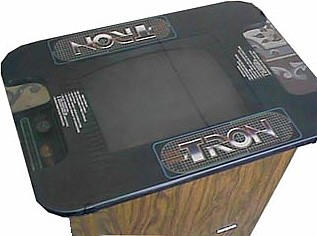
Released in 1983, the TRON arcade game consisted of four sub-games that were part of 12 different levels. The levels were named after computer languages and terminology that carry into today. The levels specified are RPG, COBOL, BASIC, FORTRAN, SNOBOL, PLI, PASCAL, ALGOL, ASSEMBLY, OS, JCL, and USER ranging from easiest to hardest.
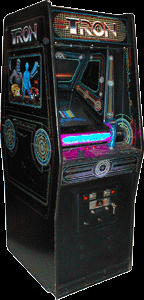
The player navigated through the sub-games on each level by making use of a dual control system of a paddle knob and a joystick. The paddle knob was often used for weapon direction while the joystick was used for character direction, weapon firing, and in one case speed control. The sub-games are listed below:
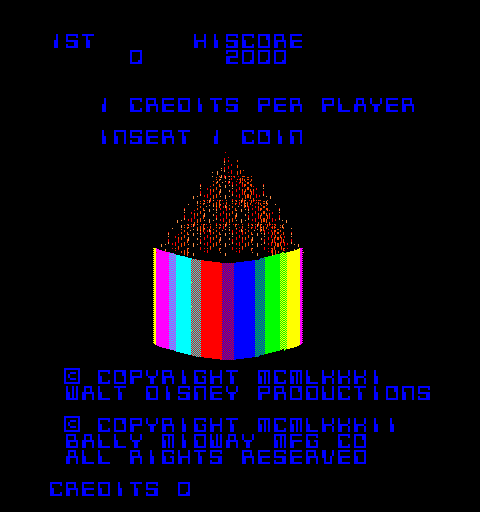
Gridbugs
Based on characters that appeared for only three seconds in the movie (not sure which three) TRON must enter the flashing circle representing the I/O tower before time on the clock expires. Armed with a laser that the player rotates with the paddle knob, TRON must fight through the multiplying grid bugs blasting his way through. As TRON progresses through levels the bugs become more numerous and the clock runs shorter. TRON must never touch a grid bug or he will derezz (die).
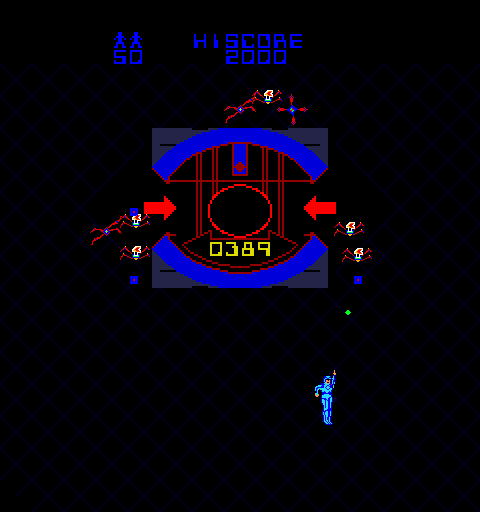
Light Cycles
A fixture in the TRON mythology, players make use of the joystick alone as TRON must surround his opponent in a trail of light that becomes hard as a wall. TRON rides the blue light cycle while his opponent rides the yellow. Players use the joystick to move and the trigger to determine how fast they went. It is ironic, however, that TRON rides the blue light cycle in the game and his opponents ride the yellow while in the movie it was the other way around.
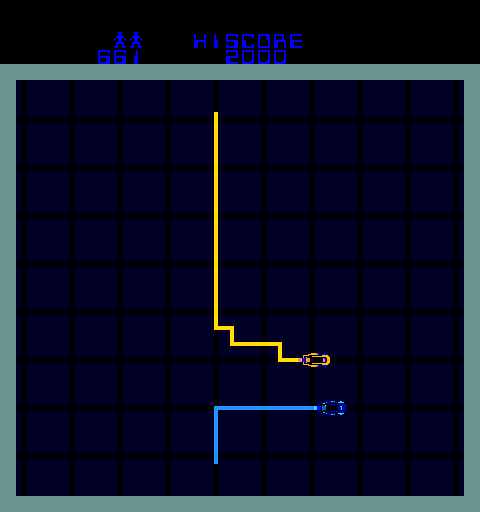
MCP Cone
In this game, TRON must blast his way through 6 to 8 rows of blocks that can rotate clockwise or counterclockwise depending on the level as he seeks to enter the MCP cone. Again using the rotating blaster, TRON blasts blocks out of his path as he makes his way to the cone. Complicating things are the blocks moving down towards TRON, which, if he touches one, he derezzes. A 1000 point bonus is awarded for hitting all blocks as well as a 1000 point bonus for entering the cone.
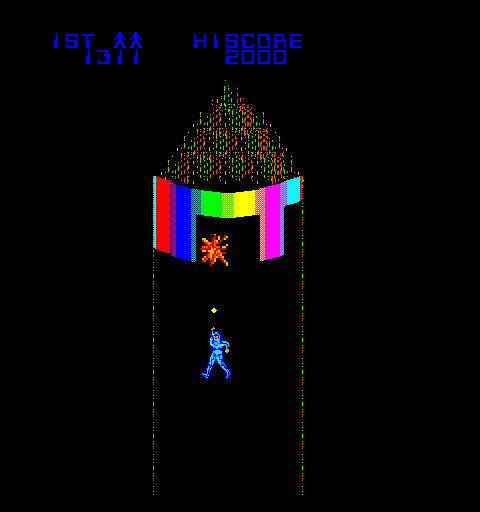
Enemy Tanks
TRON is driving a red tank which he must use to destroy enemy blue tanks, and in later levels Recognizers. Starting out he only has to deal with one tank but then he has to deal with more as the game continues. The joystick controls tank direction and firing while the paddle knob controls turret direction. TRON can deal with anywhere between 1 to 5 tanks and/or Recognizers on a level, and to destroy his adversaries TRON must hit a tank or Recognizer three times while it takes an enemy only one shot to destroy TRON. If TRON drives into the purple area in the center of the screen then TRON is warped to a random area on the maze.
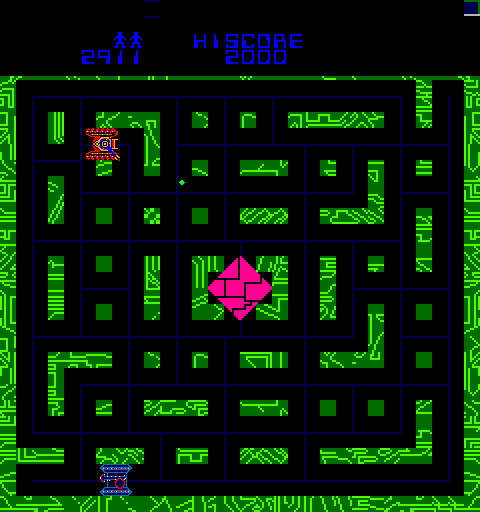
Disks of TRON
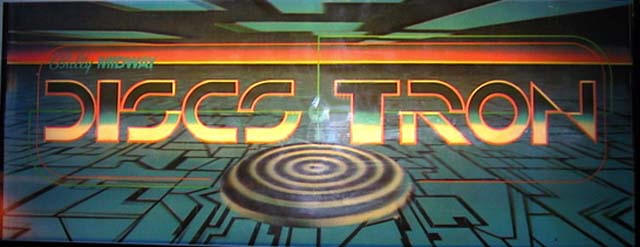
Released by Bally Midway in 1983, the second arcade game was originally intended to be a fifth sub-game in the original TRON arcade game, but due to lack of space this game was never included. Hence the familiar controls for TRON were used.
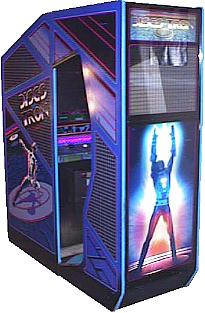
Designed by Robert Dinnerman, Disks of TRON was inspired by two games in the TRON movie. One was where TRON was fighting evil warriors with his disk being his only weapon. The second where Flynn stood on a ringed disk fighting a competing program, sending him derezzing into the abyss below. These sequences also went on to inspire the game TRON: Deadly Disks for Intellivision, M Network and Aquarius.
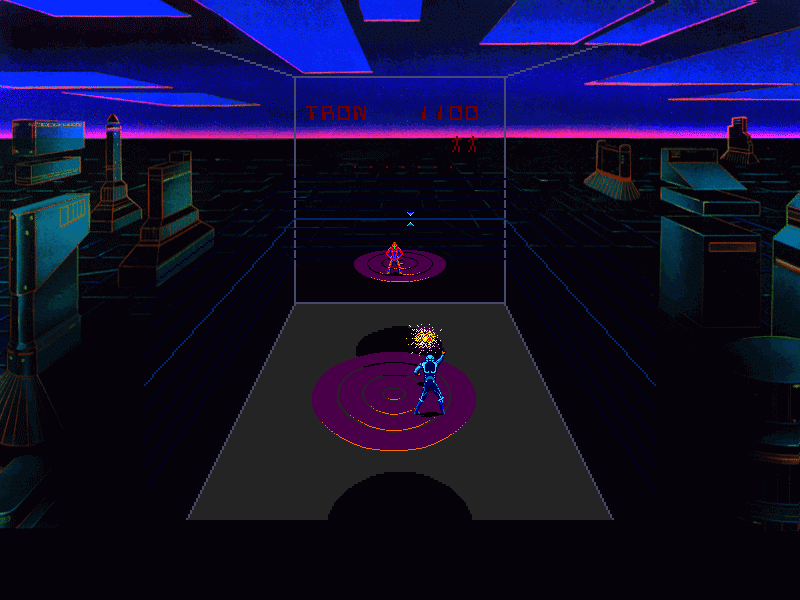
In Disks of TRON the player is TRON, who stands on one disk, or bounced between several, trying to hit their red opponent or push him off into the video abyss. As TRON, you are armed with a series of disks and a deflector to drive back the red warrior’s weapons, which consist of disks, a chaser, and a super chaser which TRON must destroy with his own disks.
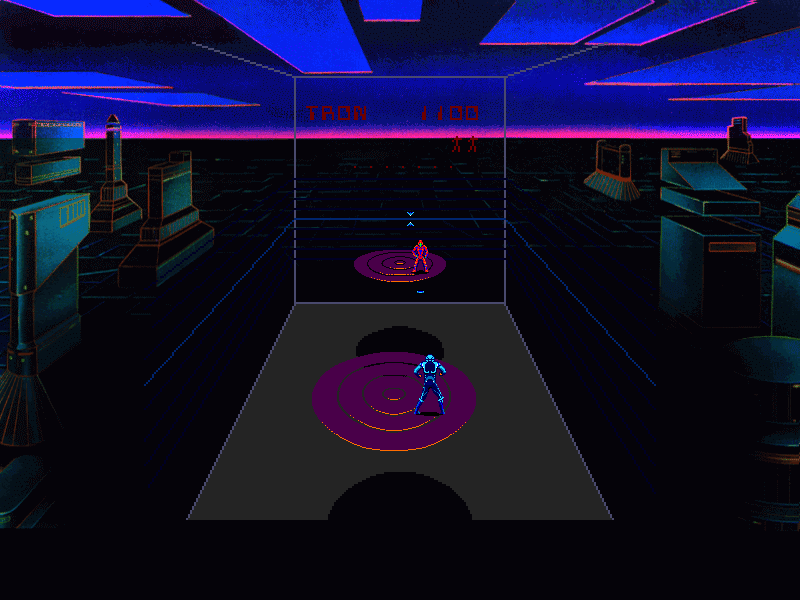
Disks of TRON was released before the video game crash of 1983, when MTV was replacing games as the big popular thing. There were also cabinet versions released designed by George Gomez where a player could stand in a cabinet and play the game. A version was also reported to have been released for the Commodore 64, and one was reported to be released on Amstrad CPC in 1990.
Game art for Disks of TRON was done by Brian Colin, with concept art by Earl Vickers. Hardware was done by Atish Ghosh and the Group Manager was Bill Adams. It was also played on a horizontal monitor of Raster type with a standard resolution of 512 by 480 with 16 colors.
Video Games
Following the movie TRON came a series of video games. Two coin operated games above, and a series of home games produced by Mattel Electronics. These home games were primarily used for their Intellivision system, but games were also released for the Atari 2600 under the label ‘M Network’ and one for the short lived Aquarius system which was also produced by Mattel Electronics.
Intellivision Video System
In 1977 Mattel toys opened an electronics division that released a series of hand held electronic games. At the same time the Atari Corporation released the Atari Video Computer System (then known as the Atari VCS – but would soon be changed to the Atari 2600). This system connected to a TV, and allowed the world of video games to come into the homes of millions.
Upon release of the Atari VCS, Mattel executive Richard Chang worked with Glenn Hightower of APh Technology Consulting to come up with a system that could compete with the Atari VCS. Test marketed in 1979, and released in 1980, this system was called ‘Intellivision’.
Mattel Electronics stressed that Intellivision was not a toy, but actually an educational tool that was the heart of a computer education system. Billed as ‘Intelligent Television’, and stressing the superior graphics to the Atari VCS, Intellivision went into direct competition with the Atari’s system.
The video game wars were on, and a participant of those wars was TRON.
4 games were released for Intellivision. Here is the story on them.
TRON-Deadly Disks
 |  |
Also known as TRON I, this game was designed by Steve Sents who also served as programmer. Eric Wels worked on graphics, and Bill Goodrich was responsible for sound. TRON: Deadly Disks was developed at the same time the movie was made with Sents, Wels and Goodrich making use of production stills and storyboards from the movie.
Originally intended to sell 350,000 copies Mattel decided to try and increase marketing to 800,000 in anticipation of popularity of the movie. Mattel also expected the international demand for TRON to eliminate any downside risk. Those expectations fell way short as the Intellivision game sold only 300,000 copies.
In this game, TRON has to battle adversaries with his disk as his only weapon. Going against evil video warriors and the occasional Recognizer, TRON has to defend himself against his attackers armed with disks of their own. The adversaries come at TRON in a 3 on 1 fashion. Players had to use skill and smarts to defeat adversaries that got more dangerous as the game progressed, especially against the hard to destroy Recognizer that swooped in ready to derez TRON.
Other versions of TRON: Deadly Disks would be released for Mattel’s M Network division and the short lived Aquarius computer, also produced by Mattel.
TRON-Maze-A-TRON
 |  |
Also known as TRON II, Mazeatron and just Maze-A-Tron, TRON: Maze-A-TRON was developed alongside TRON: Deadly Disks. Making use of the same production stills and story boards from the movie. Like TRON: Deadly Disks, TRON: Maze-A-TRON was produced and developed just as the movie was being made.
Also like TRON: Deadly Disks, TRON: Maze-A-TRON suffered from lackluster sales due to the lukewarm reception received by the movie.
Designed and programmed by Russ Hoft, with graphics by Eric Wells and sound by Andy Sells, the player of the game had to navigate TRON through a maze hoping to penetrate the inner circle of the MCP. Along the way TRON had to face and destroy deadly bits, and avoid getting hit by the Recognizer, which would send TRON back to the beginning of the maze.
The Intellivision catalog said TRON: Maze-A-TRON was a one or two player game, but in actuality it was a single player game.
Adventures of TRON
Designed to be an Intellivision version of M Network’s Adventures of TRON game, this game is virtually identical to its M Network counterpart with the exception of the title screen of the game. This screen (making use of techniques intended for the never released Intellivision III-which was intended to be a direct competitor for the short lived Colecovision) was a cycling of colored bands from the center of the screen radiating at a hypnotically high speed.
The Intellivision conversion of Adventures of TRON was done without prior knowledge of Mattel management. Nevertheless Mattel paid $27,000 for the game. Intellivision however never released the Intellivision version of Adventures of TRON, due to weak performance of the TRON movie.
The story of Adventures of TRON lies in the M Network section of this article.
TRON: Solar Sailer
 |  |
The fourth game released by Intellivision was intended to be a companion game for the Intellivoice module that allowed the games to talk to players. This game offered advice to players, encouragements and passwords that helped players accomplish their missions.
Designed by Keith Robinson and Don Daglow, programmed by Robinson and Gene Smith, as well as graphics by Robinson, this game also featured voice talents of Cory Burton as TRON, Diane Pershing and Patti Glick as YORI, Brian Cummings as the MCP, Joannie Gerber as Bit and Fred Jones as a mechanical voice. Daglow started the game, but when he received a management promotion Robinson took over.
This game also had music by Andy Sells who made use of the TRON music by Wendy Carlos. Mattel was not sure if their license to the TRON property allowed the use of Carlos’ music. And although Mattel said that they would check on that, they never replied back. Regardless of the lack of reply by Mattel the music was used anyway.
According to instructions the player is Flynn, who makes use of a Solar Sailer to go across the computer world to confront the MCP and make it back to the real world. Along the way the player must avoid Recognizers and tanks that fire on the sailer until they reach the MCP where the player must engage in frantic decoding action.
Solar Sailer is considered a two level game, with the first being the Solar Sailer trip and the second being the decoding level. The first ‘level’ is divided into 8 sectors giving the game, in essence, 9 levels.
M Network
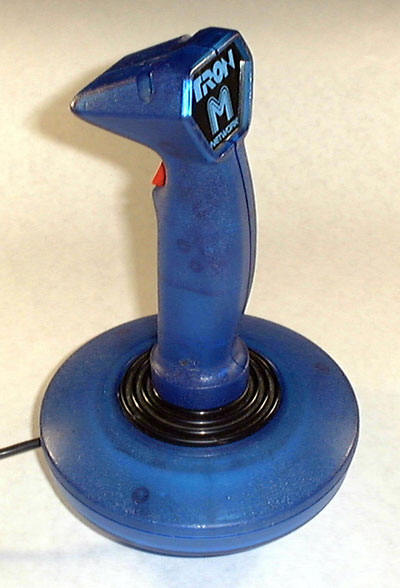
A line of games created for the Atari VCS (now commonly referred to as the Atari 2600) by the Mattel Corporation, M Network was considered in commercial ads parodying the song ‘Summertime Blues’ as ‘the cure for the video blues’.
The decision by Mattel to make a line of games for the Atari 2600 was controversial to say the least, especially since Mattel had the competing Intellivision system and there were those that felt selling games for a competing, to some inferior, console would add credibility to the system. At the end of the day numbers won out as figures had the Atari system in 10 million homes while the Intellivision was in only 2 million. In a business sense Mattel saw the point in selling games to 12 million homes than just the 2 million that had Intellivision.
M Network was the brain child of Glenn Hightower of APh Technology Consulting, whose company was contracted to produce the first Intellivision games. But APh was contracted to sell each game to Mattel for less than $30,000. The Intellivision games retailed for $30 and sold an average of 50,000 copies each with APh receiving no royalties.
To that end Hightower and their senior staff decided to try programming for the Atari 2600. To get around legal loopholes with Mattel APh’s senior programmers took a leave of absence from APh with Hightower paying them out of pocket to reverse engineer the Atari 2600, find out how the games worked and make their own demos which they could sell to Mattel or a higher bidder.
Mattel was that bidder as Hightower said that an ‘outside group’ had experience with the Atari 2600 and that APh could purchase their development tools. This was semi-truthful as the engineers didn’t work for APh at the time, and were represented at negotiations by a friend of Hightower’s. As a result, Hightower got hefty fees, plus royalties, out of the Atari deal since he had to pay his ‘outside group’ leaving APh with a contract worth millions. Far more than the Intellivision contract was considered being worth.
Code named ‘Irata’ (Atari spelled backwards), M Network games were Atari versions of Intellivision games with name changes. With the exceptions of Lock ‘N’ Chase (which was an arcade title licensed from Data East USA) and TRON: Deadly Disks. The other TRON game from M Network, Adventures of TRON, was so different from the game it was based on (TRON: Maze-A-TRON) that the name was changed.
Only two TRON games were made for M Network. This is their story.
TRON: Deadly Disks
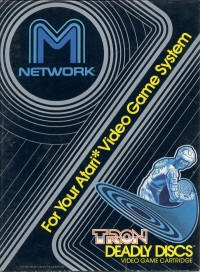 | 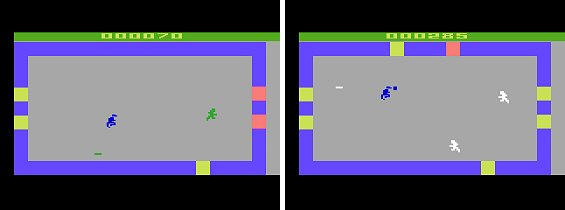 |
In the M Network version APh received full production credit for the game programmed by Jeff Ronne and Brett Stutz.
The M Network version was similar in practice to the Intellivision version, yet not considered as graphic. Also the Recognizer does not appear in this version of TRON: Deadly Disks. However that does not stop TRON from having to battle evil video warriors that TRON has to destroy with his disk before those warriors destroy him with theirs.
M Network also made a PAL version of TRON: Deadly Disks to be sold overseas. It was also sold as a package deal with ‘Adventures of TRON’ where if a consumer bought both games they would receive a free TRON joystick similar in design to the joystick used for the TRON arcade games.
Adventures of TRON
 |  |
Designed and programmed by Hal Finney Adventures of TRON was considered to be a conversion of TRON: Maze-A-TRON for the M Network. But since the finished product was so different in practice and design M Network went with the name ‘Adventures of TRON’ instead of calling it TRON: Maze-A-TRON.
Instead of just bits and Recognizers Adventures of TRON had opponents facing different foes as well as Recognizers. Also appearing that TRON had to deal with were grid bugs, which only had a cameo in the movies yet featured in the TRON arcade game as characters in a subgame. Another foe TRON had to face were tanks, which were also featured in a subgame in the arcade version.
Even though Adventures of TRON was similar in concept to TRON: Maze-A-TRON it came out so different that it seemed like a separate game. So separate that Mattel paid $27,000 for it so an Intellivision version could be made and put on the market. The Intellivision version was never released.
Adventures of TRON was sold alongside TRON: Deadly Disks as a promotion where if both games were purchased the consumer received a free TRON joystick.
Kingdom Hearts II
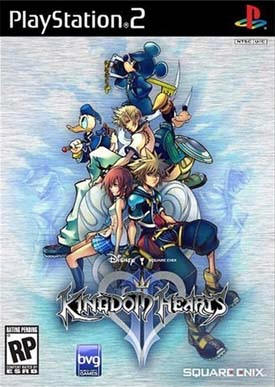
I make no apologies for including Nintendo/Sony/X-Box in the story of TRON games. As such TRON does appear in this game, and since Nintendo was a factor in the early days of the second decade of the video game wars (which seem to have become a story within a story in these articles) I felt compelled to include this chapter.
By 1982 to 1983 the video game wars were in full swing as there was a three way race between Atari, Intellivision and the new kid on the block Colecovision-which had superior graphics to Intellivision. To combat Colecovision, Intellivision was going to release the Intellivision III and Atari was releasing its new 5200 system.
Both systems met difficulty as the 5200 could not play 2600 cartriges. And the Intellivision III was met with so many delays, not to mention Mattel Electronics was falling into so much debt, Intellivision III was never released. Colecovision however faded into obscurity a year or so after release, and Mattel Electronics (and with it M Network) closed in January 1984.
Atari continued to produce games throughout the 80’s, some for the 5200 and some for their new 7800 system which was theorized to play 2600 games. Intellivision, refusing to die, was bought out by INTV corporation to produce new games throughout the 80’s. But when Nintendo unveiled their Nintendo NES Atari and Intellivision fell by the wayside. The video champions were dethroned.
Nintendo continued on as it unveiled new games and systems from the NES to Super NES to Game Boy to the current Game Cube. Nintendo also met competition with rival Sega with their Genesis, Saturn and Dreamcast systems, but they were never able to catch up with Nintendo’s success. Atari tried to re-enter the home game arena with the Lynx and Jaguar systems, but soon fell into game development along with Sega.
The only contenders for Nintendo’s throne were Sony with their Playstation (PS1), Playstation 2, and the soon to be released Playstation 3, and Microsoft’s X-Box and X-Box 360. Some games were made exclusively for their respective systems while others were made by other companies for all three systems.
One of these games was Kingdom Hearts II made by Square Enix in partnership with Disney Interactive.
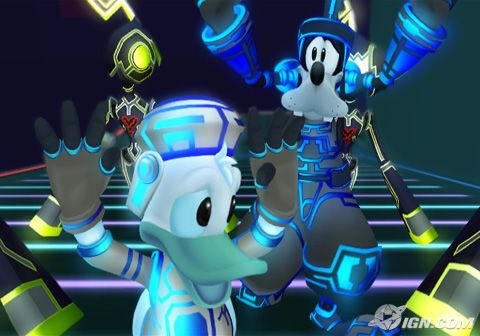 | 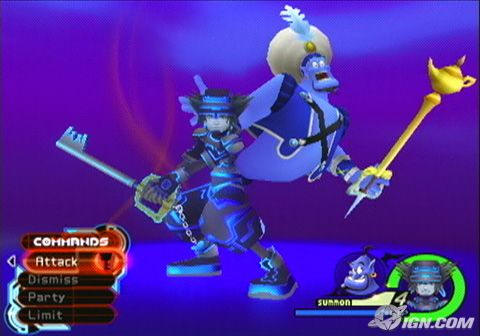 |
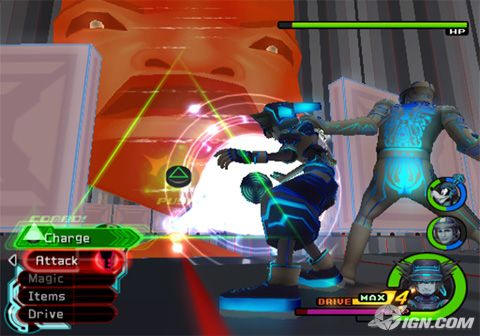
In this game Mickey Mouse joins Donald Duck, Goofy and a character named Sora from the Final Fantasy series as they journey through several different worlds in the universe of Disney, as they face an enemy called ‘the Heartless’ and a mysterious mummy wrapped ruler. Worlds that are visited range from the Land of Dragons in Mulan to Beast’s castle in ‘Beauty and the Beast. Olympus Coliseum in Hercules to the 100 Acre Wood in Winnie the Pooh, along with others. Also included in this game is ‘the world of Space Paranoids’ from the movie TRON.
In this game Bruce Boxleitner reprises his role of TRON as Donald, Goofy and Sora appear in the computer world of the ENCOM 5-11. All three appear wearing armor of blue video warriors similar to that of TRON’s. Donald, Sora and Goofy soon join forces with TRON as they have to expell the Master Control Program from the System. SARK also makes an appearance, and it is believed that Jeff Bridges also appears in this game reprising his role as Flynn.
As of this writing Kingdom Hearts II has not been released, nor has this author picked up or reserved a copy. But this writer may do so if for no other purpose than the possibility of seeing Donald Duck on a light cycle. It may not happen. But it would be fun to imagine.
Written by JSC1